Maple Moon Sugarbush & Winery
by
Terry Sullivan
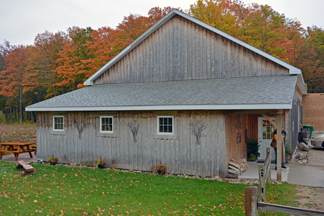 Summary: Visitors to Maple Moon Sugarbush & Winery can expect to learn the process of producing maple syrup. They also have the opportunity to taste different maple syrups and different maple wines from dry to sweet.
Summary: Visitors to Maple Moon Sugarbush & Winery can expect to learn the process of producing maple syrup. They also have the opportunity to taste different maple syrups and different maple wines from dry to sweet.
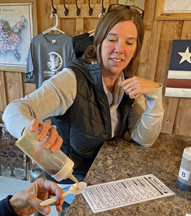 Maple Moon was established in 2011 by Todd and Christi (pictured left) Peterson who purchased the property in 2008 and moved onto the property in 2009. Christi was a teacher and Todd was and continues in construction. The couple were building houses and then selling them. They used their own funds to build a house on the property that was covered with maple trees. In 2012 they were making maple syrup and selling it at the building on the property that houses the winery tasting room. Their maple syrup was also sold at farmer’s markets. In 2015, Todd and Christi expanded their business to become the first and only commercial maple winery in the country.
Maple Moon was established in 2011 by Todd and Christi (pictured left) Peterson who purchased the property in 2008 and moved onto the property in 2009. Christi was a teacher and Todd was and continues in construction. The couple were building houses and then selling them. They used their own funds to build a house on the property that was covered with maple trees. In 2012 they were making maple syrup and selling it at the building on the property that houses the winery tasting room. Their maple syrup was also sold at farmer’s markets. In 2015, Todd and Christi expanded their business to become the first and only commercial maple winery in the country.
Christi took us on a tour of the maple syrup production area where we learned about the process of making maple syrup.
Maple Syrup Process
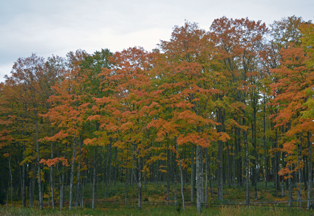 |
During late winter to early spring as the temperatures warm, the sugar maple will turn starch back into sugar. At Maple Moon, only trees twenty-five years old and older are tapped for sap. There are 4,500 taps that delivers about 80,000 gallons of sap. The sap is crystal clear and is only about two percent sugar. It usually takes 40 gallons of sap to make one gallon of maple syrup. However, at the end of the season, the sap is less than 2% sugar and requires more gallons to make a gallon of maple syrup. At Maple Moon Sugarbush & Winery, pipelines, tubing and conduits help the sugar maker pump the sap to the sugarhouse. |
| Close by the pump, a reverse osmosis unit removes a percentage of the water from the sap prior to the evaporation unit. Coming into the reverse osmosis the sap is 2% sugar. The unit removes water and increases the sap to 8% sugar. | 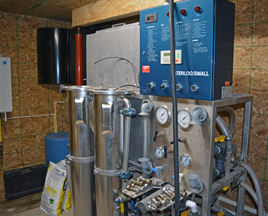 |
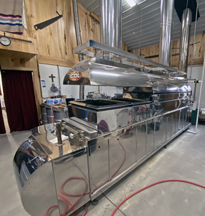 |
The evaporator unit then removes more of the water. The sugar maker wants the finished maple sugar to measure around 67 Brix. Maple Moon's minimum Brix reading is 66.5. Above 68 Brix the maple syrup can crystallize. |
| After reaching the desired Brix level, the maple syrup is filtered and graded. | 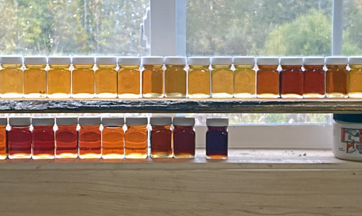 |
Maple Wine
The lighter colored maple syrup is used for winemaking. The maple syrup is packed into drums and taken off-site to produce the wine. In the future, Todd and Christi hope to have the wine production onsite. We were curious how much water is added to the maple syrup in order to make wine. Our experience in mead making included fermenting one part honey to two parts water. Christi mentioned that they also use 1 part maple syrup to two parts water to ferment and produce the maple wine.
Maple Syrup and Wines
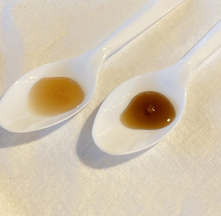 Christi started our tasting with three types of maple syrup: a grade A (pictured left, first spoon), a grade B (pictured left, second spoon) and a maple syrup aged in a used bourbon barrel. We noticed the difference in color profile. The Grade A was an amber color and tasted like maple syrup. The Grade B was a dark amber/brown color and had a robust maple taste. It reminded us of dark brown sugar and was Kathy’s favorite. My favorite was the Bourbon Barrel Aged Maple Syrup that had an amber color. The bourbon taste from the barrel complemented the maple syrup flavor.
Christi started our tasting with three types of maple syrup: a grade A (pictured left, first spoon), a grade B (pictured left, second spoon) and a maple syrup aged in a used bourbon barrel. We noticed the difference in color profile. The Grade A was an amber color and tasted like maple syrup. The Grade B was a dark amber/brown color and had a robust maple taste. It reminded us of dark brown sugar and was Kathy’s favorite. My favorite was the Bourbon Barrel Aged Maple Syrup that had an amber color. The bourbon taste from the barrel complemented the maple syrup flavor.
We tasted four wines. The viscosity of the wines was the same as grape wines and not as thick as maple syrup. The Early Spring Reserve had 12% alcohol and 0 g/L of residual sugar. This dry wine had a light yellow color. Oak, maple syrup and a hint of bacon were noted on the aroma and taste. The finish was crisp with a perceived sweetness from the maple syrup even though the wine was dry.
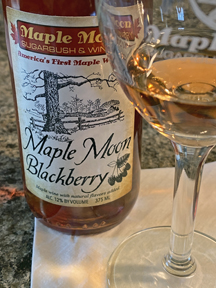 The Maple Blackberry wine was a blend of maple wine and blackberry wine. The 12% alcohol wine had 45 g/L of residual sugar. The salmon colored wine had blackberries and maple on the aroma and taste with a very faint taste of bacon. On the finish the maple flavor yielded to blackberries.
The Maple Blackberry wine was a blend of maple wine and blackberry wine. The 12% alcohol wine had 45 g/L of residual sugar. The salmon colored wine had blackberries and maple on the aroma and taste with a very faint taste of bacon. On the finish the maple flavor yielded to blackberries.
The Maple Gold is the wineries number one selling maple wine. The yellow colored wine had 18% alcohol and 98 g/L of residual sugar. The wine was craftedby adding their bourbon to the wine to raise the alcohol to 18%. The first thing noted was that there was no alcohol burn on this wine. Bourbon and maple syrup were on the aroma and taste. The wine had a very velvety mouthfeel. Sip this wine next to a fireplace on a cold winter’s day.
The Maple Royal was a dessert wine. The wine was fermented dry then back sweetened with maple syrup. The light yellow colored wine had a green hue. It had 12% alcohol and 120 g/L of residual sugar. It tasted like maple syrup and was sweet.
Retail Shop
The retail area has an assortment of maple syrup related items. In addition to the wines, visitors can purchase maple syrup, maple candy, maple sugar, maple cream, maple root beer, jams and jellies, salsas and sauces and Michigan honey.
Wine enthusiasts can experience a different type of wine made with maple syrup. Christi wants people to know that Maple Moon Sugarbush & Winery is the first and only maple syrup winery in the United States. The thickness and mouthfeel of the wines are the same as grape wines. The wine tasting offers visitors a unique experience.
Maple Moon Sugarbush & Winery
4454 Atkins Rd.
Petoskey, Michigan 49770
GPS: N45º 21.6824’ W84º 52.7244’
Article written October 2019.
